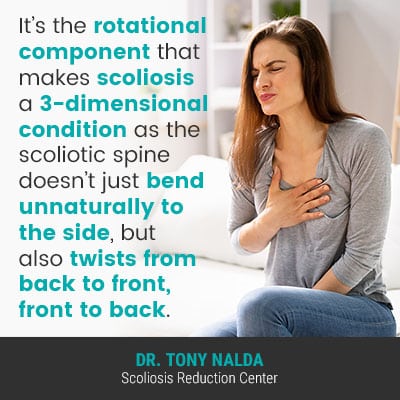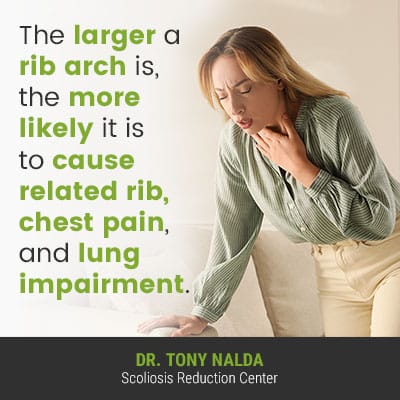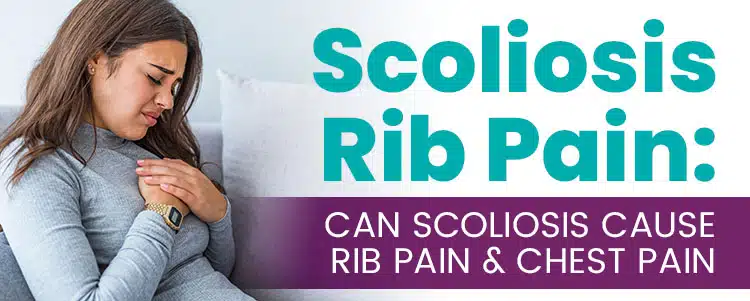While scoliosis is a spinal condition, its effects can be felt throughout the body and not just in the back. The postural deviation it causes can disrupt a patient’s posture, gait, balance, and coordination. Continue reading to find out how scoliosis can cause rib and chest pain.
One of the earliest signs of scoliosis in adolescents is postural deviation, and this is caused by the uneven forces the condition introduces to the body. As the spine develops an unnatural spinal curve, it can pull on the rib cage, disrupting its position, and this can cause rib and chest pain.
Let’s start our discussion of scoliosis rib pain by first exploring the condition itself, and some basic anatomy.
Understanding the Scoliotic Spine
A healthy spine will appear straight when viewed from the front or back and will take on a soft ‘S’ shape when viewed from the sides.

The spine’s natural and healthy curves make it stronger, more flexible and facilitate its ability to evenly absorb and distribute mechanical stress, like a coiled spring.
If the spine loses one of its healthy curves, it can disrupt the biomechanics of the entire spine, and this can lead to functional deficits; however, scoliosis ranges in severity, so what one patient experiences isn’t indicative of what others will face.
In order to reach a diagnosis of scoliosis, certain parameters have to be met; the spine has to have an unnatural sideways spinal curve with rotation and a minimum Cobb angle of 10 degrees.
It’s the rotational component that makes scoliosis a 3-dimensional condition as the scoliotic spine doesn’t just bend unnaturally to the side, but also twists from back to front, front to back.
A patient’s Cobb angle is a measurement taken during an X-ray that determines how far out of alignment a scoliotic spine is and places conditions on a severity scale:
- Mild scoliosis: Cobb angle measurement of between 10 and 25 degrees
- Moderate scoliosis: Cobb angle measurement of between 25 and 40 degrees
- Severe scoliosis: Cobb angle measurement of 40+ degrees
- Very-severe scoliosis: Cobb angle measurement of 80+ degrees
The higher the Cobb angle, the more severe the condition, and the more likely it is to cause noticeable symptoms like rib and chest pain.
When it comes to scoliosis symptoms, there is a big difference between how adolescents and adults experience the condition, and this is due to compression.
Common Symptoms of Scoliosis
Part of the reason scoliosis is so complex to treat is because, in addition to ranging widely in severity, there are also different types. The most prevalent form of scoliosis is adolescent idiopathic scoliosis (AIS), diagnosed between the ages of 10 and 18.
In adolescents, the condition’s earliest signs are often uneven shoulders and hips, and this type of postural deviation is caused by the uneven forces introduced by the unnatural spinal curve.
Symptoms of Adolescent Idiopathic Scoliosis
In addition to uneven shoulders and hips, while each case is unique, common symptoms of scoliosis in adolescents can include:
- A tilted eye line
- Uneven shoulder blades with one protruding more on one side than the other
- The development of a rib arch
- An uneven waistline
- Arms and legs that appear to hang at different lengths
Additional signs of scoliosis in adolescents to watch out for include ill-fitting clothing and changes to gait, balance, and coordination.
The main effect of scoliosis is a disruption to the body’s overall symmetry, and while having one asymmetrical feature doesn’t guarantee a person has scoliosis, it can indicate the need for further testing.
Now, when it comes to pain, this is where the adolescent and adult experiences vary widely.
Symptoms of Adult Scoliosis
While scoliosis is more common in children and adolescents, it also affects adults; the two most common forms to affect adults are idiopathic and degenerative scoliosis.
While the main symptom of scoliosis in adolescents is postural deviation, in adults, the main scoliosis symptom is pain, and this is because the condition doesn’t become compressive until adulthood.
In children and adolescents, the condition isn’t commonly painful, other than related muscle pain, because the condition is not yet compressive; due to the constant lengthening motion of a growing spine, the compressive force of an unnatural spinal curve is counteracted.
Once skeletal maturity is reached, the spine becomes vulnerable to compression of the spine and its surrounding muscles, ligaments, and nerves, and this is the main cause of condition-related pain.
So while adults can experience the same types of postural deviation as adolescents, including a prominent lean to one side, it’s pain that brings most adults in to see me for a diagnosis and treatment.
When it comes to rib and chest pain, who’s likely to experience it, and what is it caused by?
Pain in Ribs as a Scoliosis Symptom

As mentioned earlier, one of the main types of postural deviation associated with scoliosis is the development of a rib arch.
There are three main spinal sections: cervical (neck), thoracic (middle and upper back), and lumbar (lower back).
Scoliosis can develop anywhere along the spine but is most common in the thoracic spine, and this location is most associated with the development of a rib arch as an unnatural spinal curve in the middle/upper back is closest to the rib cage.
A rib arch can develop because, as a 3-dimensional condition, the spine twists, and so does the chest, which can cause the ribs on one side of the back to protrude more than the other, and this is most noticeable when in a forward-bend position.
Generally speaking, noticeable rib pain is more common in adults when scoliosis is severe, or particularly if left untreated or not treated proactively.
If left untreated, as a progressive condition, related postural deviation increases alongside condition severity, including rib arches, and as a rib arch increases in size, the body is more affected, particularly in terms of potential lung impairment and related chest pain.
Chest Pain as a Scoliosis Symptom
The larger a rib arch is, the more likely it is to cause related rib, chest pain, and lung impairment.
While more common in severe forms and often only noticeable in people placing higher-than-average demands on their respiratory systems, lung impairment can develop as the space inside the chest is affected by the change to spinal and rib positioning.
As a rib arch gets bigger, it leaves less space for the lungs to function within, and while an average person is unlikely to notice a decrease in lung space, athletes or those with particularly severe forms of scoliosis can develop noticeable lung impairment and related chest pain.
The angle of trunk rotation (ATR) can also factor into how painful a condition is, particularly when it comes to rib and chest pain, so the higher a patient’s Cobb angle and degree of trunk rotation, the more painful it’s likely to be.
In addition, it’s not just the spine that’s in charge of maintaining its natural curves and alignment, but also its surrounding muscles, and as mentioned, once skeletal maturity has been reached, and compression comes into play, core muscle soreness and spasms can develop as the muscles struggle to support the unnaturally-curved spine.
So scoliosis can cause rib and chest pain in three main ways: postural deviation, compression, and stiff, sore, and strained chest muscles.
Conclusion
While scoliosis is a structural spinal condition, it can affect the body in many different ways.
Scoliosis is the development of an unnatural sideways spinal curve, and as a progressive condition, where scoliosis is at the time of diagnosis is not indicative of where it will stay.
Scoliosis that’s diagnosed as mild can easily progress to moderate, severe, and very severe, especially if left untreated; only proactive treatment can counteract the condition’s progressive nature and prevent increasing condition severity and escalating symptoms.
While postural deviation is the main symptom of scoliosis in adolescents, it’s pain that brings the majority of adults in to see me for a diagnosis and treatment.
Adults tend to find scoliosis more painful than children and adolescents because once skeletal maturity has been reached, it becomes a compressive condition.
So while adolescents can also experience postural deviation that affects the ribs and chest, adults are more likely to find it painful, and when it comes to rib and chest pain, this is caused by a rib arch leading to less space within the chest for the lungs to function, related lung impairment, and stiff and sore core muscles as they struggle to support a scoliotic spine.
Here at the Scoliosis Reduction Center®, patients benefit from a proactive conservative treatment approach that starts treatment as close to the time of diagnosis as possible in an effort to prevent progression, increasing condition severity and escalating symptoms such as rib and chest pain.




